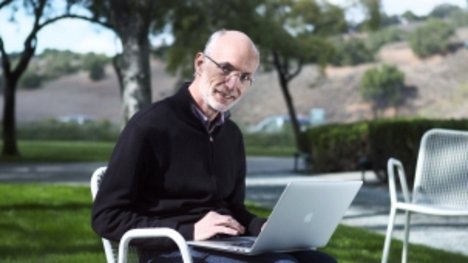Transforming the world of hard disks – and another brain wave.

Materials research enters a new dimension
Big data, cloud computing, live streaming on the internet – in the era of Facebook, Google, Youtube and so on, life without these technologies is almost inconceivable. These technologies are also inconceivable without the scientist who created the physical bases for them: Stuart Parkin. With his groundbreaking work on magnetic data storage materials at the IBM Almaden Research Center in California, he succeeded in increasing the data density on hard disks by a factor of 1,000. In 2014, he was awarded with the Millennium Technology Prize from the Finnish Academy for Technology for his "key to the era of big data". This honour, which is endowed with one million Euros, is seen as being a kind of Nobel Prize in the field of technical and medical innovations.
A turning point in a lifetime of research
It felt like the right time for a re-orientation in a lifetime of research - and it involved a daring move by a highly acclaimed solid state physicist all the way from the Pacific coast of the USA to the city of Halle / Saale in the federal state of Saxony-Anhalt. Stuart Parkin has been stationed in Halle as Director of the Max Planck Institute for Microstructure Physics and Alexander-von-Humboldt Professor at the Martin-Luther University of Halle-Wittenberg since April 2014. He is continuing his research into new materials and concepts for the data storage of the future on the Weinberg campus. For the wiry Englishman, after spending decades at IBM and Stanford University, the move also means his return to Europe.
New prospects in Halle
"Being the Director of the Max Planck Institute is one of the best jobs in the world," explains Parkin. "An excellent environment and excellent colleagues are available here for the kind of long term research that I'm doing." And his new colleagues view him as being a huge benefit to their team. Stuart Parkin is also bringing additional first rate researchers with him to Halle, giving the superb materials search here an added boost, and not least to his strength in developing new things into profitable applications. Ninety patents already carry his name.
Inspiration with spin
"I find creating artificial materials to be extremely interesting. You not only come across areas where nobody has ever been before, you can also transform knowledge into a useful application that has a major social impact – and can even transform society," highlights Parkin. An example of this is "Spintronic", a form of electronics which is not only based on the charging of the electrodes but also uses their spin. This can be understood as being a rotation on the individual axes which turns the electron into a small magnet. This results in brand new possibilities for the transportation and storage of data and new logical components. The associated effects have already enabled the hard disk technology developed by Parkin at IBM. Yet the potential of the spin technology is far from being exhausted, and is all set to continue to provide the physicists with further inspiration in Halle.
The next memory revolution
For Stuart Parkin the next spin revolution is already in the pipeline: even higher storage densities with so-called 3D racetrack memories. These consist of loops made from nanowire which are upright, as in a carpet, and therefore enable extremely high storage densities. The magnetic field – divided into small, differently polarized sections – is able to move forwards and backwards on the reading head, driven by spin-charged current pulses.
Parkin believes the future, however, to lie in cognitive memories, which work in a similar way to the human brain, the strength of which is its unbelievable efficiency. Cognitive computers solve problems in a different way from conventional ones: they don't travel along sophisticated pre-determined paths from A to B, but adapt to the task in question and offer the shortest path. This may not always provide the exact solution – but it provides one which is sufficient in many cases. It is naturally the case that new, artificial materials and production techniques are required for this close-to-nature concept, a challenge for which Halle is able to provide the physicist with excellent prospects for success.
Contact:
The Alexander von Humboldt Foundation
Strategy and External Communications
Press, Communication and Marketing Department
Jean-Paul-Str. 12
53173 Bonn
Tel.: +49 228 833-450
Fax: +49 228 833-441
www.humboldt-foundation.de
